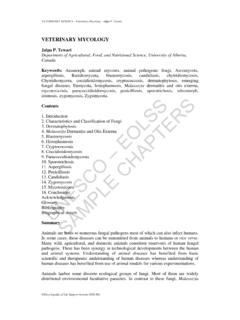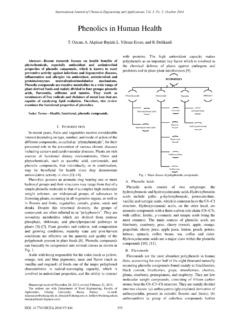Transcription of Arsenic, microbes and contaminated aquifers - Mono Basin
1 arsenic , microbes and contaminated aquifersRonald S. Oremland1and John F. Geological Survey, Menlo Park, California 94025, CA, USA2 Department of Biological Sciences, Duquesne University, Pittsburgh, Pennsylvania 15282, PA, USAThe health of tens of millions of people world-wide is atrisk from drinking arsenic - contaminated well water. Inmost cases this arsenic occurs naturally within the sub-surface aquifers , rather than being derived from ident-ifiable point sources of pollution. The mobilization ofarsenic into the aqueous phase is the first crucial step ina process that eventually leads to human evidence suggests that this is a microbio-logical does not normally associate arsenic with life, but it isnow apparent that various types of microorganisms gainenergy for growth from this toxic element[1](Box 1).
2 These organisms are taxonomically diverse and metabo-lically versatile (Figure 1). For example, aqueous arsenicin theC3 oxidation state, arsenite [H2 AsO3 Kor As(III)],canbeoxidizedtoarsenate[HAsO42 Kor As(V)] bychemoautotrophic arsenite-oxidizing bacteria (CAOs; seeGlossary). These organisms use oxygen or, in some cases,nitrate as their terminal electron acceptor during thefixation of inorganic carbon (CO2) into cell material. Thereare also heterotrophic arsenite oxidizers (HAOs), but theyneed organic carbon as their source of energy and cellmaterial. On the reductive side are microbes that useAs(V) as an electron acceptor in anaerobic prokaryotes oxidize a variety of organic ( lactate,acetate, formate and aromatics), or inorganic (hydrogenand sulfide) electron donors, resulting in the production ofAs(III).
3 We refer to these prokaryotes as dissimilatoryarsenate-respiring prokaryotes (DARPs) and their As(V)reductase as Arr. Many microbes reduce As(V) to As(III) asa means of resistance. These arsenate-resistant microbes (ARMs) do not gain energy from the process, but use it as ameans of coping with high arsenic in their that has entered the microbe s cytoplasm isconverted to As(III) through a process mediated by a smallpolypeptide (ArsC) and expelled out of the cell by anAs(III)-specific transporter (ArsB). Although the arseniteoxidases of CAOs and HAOs have notable similarities, thearsenate reductases of DARPs and ARMs are verydifferent[2].Groundwater arsenic and arsenicosisWhat does this curious microbiological phenomenon haveto do with outbreaks of arsenicosis in countries such asBangladesh?
4 It started with an effort to eliminate the highincidence of water-borne diseases caused by consumptionof untreated surface waters contaminated with highbacterial counts. The government of Bangladesh, incooperation with the World Health Organization of theBox 1. Toxicity of arsenic CompoundsArsenic occurs in four oxidation states: AsC5,AsC3,As0and two highest oxidation states are the most common in nature,whereas the two lowest are oxyanion is an analog of phosphate, and as such it is a potentinhibitor of oxidative phosphorylation, the key reaction of energymetabolism in metazoans, including most toxic of arsenic oxyanions. It readily binds to reactivesulfur atoms ((SH goups) of many enzymes, including thoseinvolved in trioxide (As2O3)The most common form of arsenic used for a variety of agricultural,manufacturing and medical purposes.)
5 It is highly toxic, and beingsoluble in water, as well as colorless and tasteless, it has proveduseful in criminal homicide. During the 18thcentury it gained somuch notoriety that it was referred to as inheritance powder .Methylated forms of arsenate and arseniteCompounds, such as methylarsonic acid (MMAV), monomethylar-sonous acid (MMAIII) and dimethylarsenic acid (DMAV) are producedby algae and as excretory products of animals. They have varyingdegrees of toxicity, depending on their chemical form and theoxidation state of the arsenic that they contain. They occur in lowconcentrations in the in theK3 oxidation state, occurring as highly toxic gases,such as H3As and (CH3)3As. Very little is known about the naturalcycles of these substances, as they occur at very low concentrationsin the compoundsNaturally occurring substances, such as arsenobetaine, are molecu-lar analogs of osmotic-regulating compounds, such as betaine,where arsenic substitutes for the original nitrogen atom.
6 Theycommonly occur in several marine animals, including shellfish andelasmobranchs. Their physiological role in these organisms isunknown, but they are benign and are not toxic to animals that eatthese organisms, including organoarsenic compoundsSubstances, such as roxarsone (4-hydroxy-3-nitrophenylarsonicacid), are used as palliatives included in the feed of mass-raisedswine and poultry. They are benign, do not accumulate in theseorganisms, and are ultimately excreted. However, their sub-sequent breakdown by bacteria in soils will release As(V) intothe author:Oremland, online 10 December 2004 UpdateTRENDS in February Nations, instituted a nation-wide switch to usegroundwater.
7 For a period of approximately 20 years,millions of wells were constructed to tap ground waterresources that were free of enterics. What was unforeseen,however, was that this would replace one water-qualityproblem (pathogens) with another one ( arsenic ). Inacademic terms, this water-usage switch replaced aproblem of medical microbiology with that of geomicro-biology. For an overview of the scope of this humantragedy in Bangladesh, the reader is referred to the recentarticle by Chowdhury[3].Where does this aqueous arsenic come from? In the caseof Bangladesh and West Bengal, India, it is present as along-term ( millions of years) consequence of rockweathering, downstream transport and sediment depo-sition of arsenic -rich minerals originally found in theHimalayas.
8 Hence, the sub-surface arsenic distribution isvery much a part of the complex alluvial landscape of thecountryside. But in practical terms, the issue boils down tothe question of the mobility of As(V) and As(III) inhydrologic systems that have both an aqueous phase anda solid phase. Very simply stated, the arsenate anion is theprevalent chemical species under oxic conditions andtends to be strongly adsorbed onto several commoninorganic mineral surfaces, especially amorphous ironminerals, such as ferrihydrite, as well as the aluminumoxides found in clays. Hence, in oxic sub-surface systemswith a high Eh(oxidation-reduction potential) and anabundance of adsorptive minerals, As(V) tends to beimmobilized by remaining sorbed onto the solid , As(III) is the prevalent chemical species underanoxic conditions (low Eh), and because it sorbs to fewer suchminerals, it partitions into the aqueous phase and is thusmore mobile (and notably more toxic) than As(V).
9 However, the above statements are clearly an over-simplification. Several laboratory and field investigationshave shown the theoretical importance of diverse chemicalphenomena at either promoting or decreasing the mobilityof arsenic in the subsurface. These can include theformation of arsenic sulfide solid phases[4], or theircarbonate-mobilized leaching into the aqueous phase[5],the enhancement or suppression of the arsenic -sorptivecharacteristics of iron minerals caused by carbonate ions[6], the competition of As(V) with phosphate (a molecularanalog of arsenate) for sorptive sites, and the considerableadsorptive affinity of various Fe-minerals for As(III)[7].Indeed, there is evidence that as iron minerals themselvesTRENDS in Microbiology Pyrobaculum aerophilumPyrobaculum arsenaticumThermus sp.
10 HB8 Thermus sp. HR13 Thermus sp. YT1 Sulfurihydrogenibium sp. HGMK-1 Clostridium sp. OhILAsBacillus sp. HT-1 Bacillus sp. JMM-4 Bacillus selenitireducensDesulfosporosinus auripigmentumDesulfitobacterium frappieriDesulfitobacterium sp. GBFHDes. hafnieseAgrobacterium albertimagniBacillus arsenicoselanatisSLAS-1 Deferribacter desulfuricansChrysiogenes arsenatisS. arsenophilumS. multivoransS. halorespiranS. barnesiiSulfurospirillum deleyianumWolinella sp. BRA-1 Desulfomicrobium sp. Ben-RbCitrobacter sp. TSA-1 Shewanella sp. ANA-3 MLMS-1 MLHE-1NT-5NT-6NT-14 Ben-5NT-3, 4, 2NT-26, 25NT-10 Alcaligenes faecalisGram + substitutions/siteDARPsCAOsHAOsArchaeaBa cteriaBen-4 Figure diversity based on 16S rRNA gene sequences of known species of prokaryotes from the Domains Archaea (top) and Bacteria (bottom) that eitherreduce or oxidize arsenic oxyanions.







